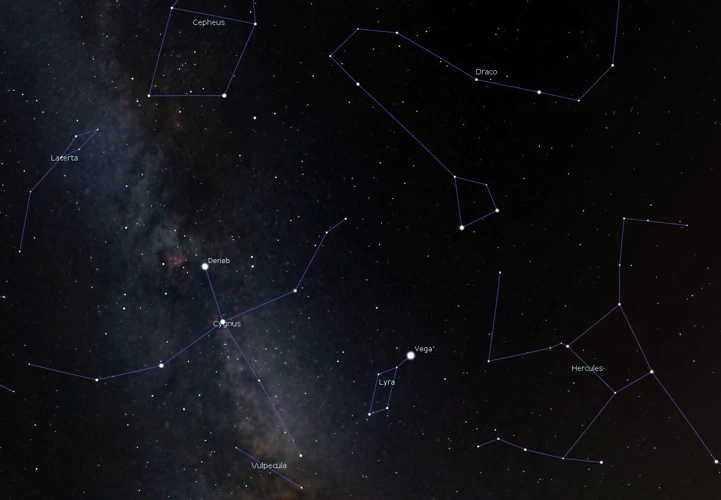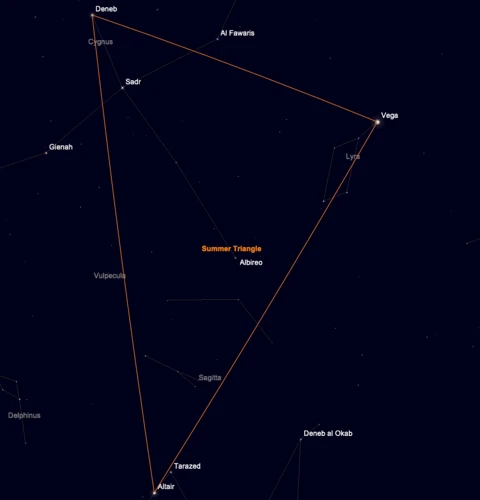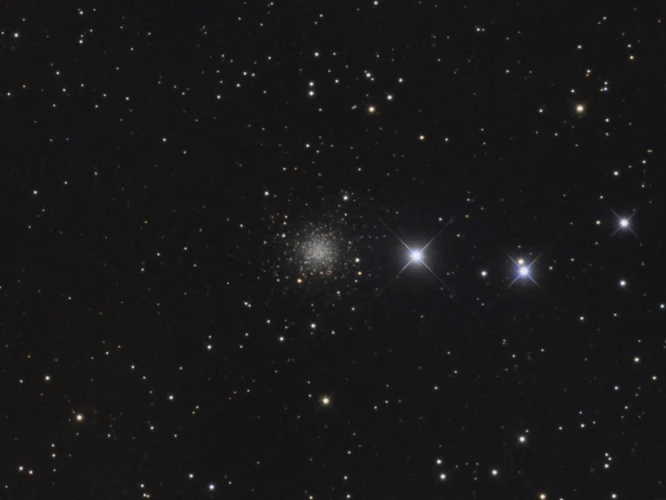The majestic constellation of Cygnus, also known as the Swan, has captivated skygazers for centuries. With its prominent shape resembling a graceful bird in flight, Cygnus stands as one of the most recognizable constellations in the Northern Hemisphere. But beyond its visual appeal, Cygnus is a treasure trove of celestial wonders waiting to be explored. From its rich mythology rooted in ancient Greek tales to its role as a stellar nursery and the home of breathtaking deep-sky objects, Cygnus offers a captivating journey into the mysteries of the cosmos. In this article, we will delve into the fascinating world of Cygnus, uncovering its mythology, guiding you to its location in the night sky, introducing its magnificent stars, and unveiling its breathtaking deep-sky delights.
Contents
- The Mythology Behind Cygnus
- Locating Cygnus
- The Magnificent Stars of Cygnus
- Cygnus as a Stellar Nursery
- Deep-Sky Delights in Cygnus
- Conclusion
-
Frequently Asked Questions
- 1. What does the Cygnus constellation represent?
- 2. How can I locate Cygnus in the night sky?
- 3. What is the significance of Deneb, the alpha star of Cygnus?
- 4. Is Albireo a single star or a binary star system?
- 5. What is the Cygnus OB2 Association?
- 6. What are some other notable deep-sky objects in Cygnus?
- 7. What is the origin of the name “Cygnus”?
- 8. Can Cygnus be seen from both hemispheres?
- 9. Is there any historical significance associated with Cygnus?
- 10. Are there any cultural references to Cygnus in literature or music?
- References
-
Frequently Asked Questions
- FAQs about Exploring Cygnus the Swan: A Dive into the Constellation of the Northern Summer
- 1. How did Cygnus get its name?
- 2. Is Cygnus visible all year round?
- 3. Can I see Cygnus from the southern hemisphere?
- 4. How can I locate Cygnus in the night sky?
- 5. What are the most notable stars in Cygnus?
- 6. Is Cygnus home to any star clusters or nebulae?
- 7. Can I observe deep-sky objects in Cygnus with a telescope?
- 8. Is there any mythology associated with Cygnus?
- 9. Are there any interesting facts about Cygnus?
- 10. Can I explore Cygnus through astro-photography?
- References
- Read More
The Mythology Behind Cygnus

The mythology behind Cygnus forms an enchanting tapestry woven with ancient stories and beliefs. In Greek mythology, Cygnus is associated with the tragic tale of Cycnus, the son of Ares, the god of war. According to the myth, Cycnus was transformed into a swan by the gods to escape the battles of Troy. This connection to the Trojan War brings a sense of heroism and sacrifice to the constellation. Legends from other cultures also embrace the idea of a celestial swan. In Chinese mythology, Cygnus is known as the Silver River, which tells the story of the forbidden love between Zhinu, a heavenly weaver, and Niulang, a mortal cowherd. Their love was so pure that it moved the gods, who allowed them to reunite once a year on the seventh day of the seventh lunar month. This tale adds a touch of romance and celestial beauty to the constellation of Cygnus.
1.1 The Greek Mythology Connection
The Greek Mythology connection to Cygnus is a fascinating aspect that adds depth to the constellation’s meaning. In Greek mythology, the story of Cycnus, the son of Ares, is closely tied to Cygnus. Cycnus was known for his exceptional strength and warrior skills, inherited from his father, the god of war. However, his destiny took an unexpected turn during the Trojan War. As a loyal ally of the Trojans, Cycnus fought fiercely on the battlefield, displaying his bravery and valor.But as the war progressed, Cycnus realized the futility and devastation of the conflict. He yearned for peace and wished to escape the horrors of war. In a twist of fate, Cycnus was transformed into a swan by the gods, finding solace in the skies instead of the bloodshed on Earth. This metamorphosis symbolized his release from the chaos of war and his transcendence into a celestial being. The Greek Mythology connection to Cygnus highlights the universal themes of heroism, sacrifice, and the desire for peace. It serves as a reminder that even in the face of adversity, there is always a chance for transformation and transcendence.
1.2 Legends from Other Cultures
- In Native American folklore, the Lakota Sioux tribe sees Cygnus as the embodiment of the Thunderbird, a powerful creature associated with storms and lightning. The Thunderbird is believed to bring life-giving rains and is revered for its strength and ability to communicate between the mortal and spiritual realms.
- In Norse mythology, Cygnus is associated with the tale of the Valkyries, the warrior maidens who choose the bravest of fallen warriors to carry them to the halls of Valhalla. It is said that in the night sky, Cygnus represents the swan cloak worn by the Valkyries as they soar across the cosmos searching for fallen heroes.
- In Australian Aboriginal mythology, Cygnus is often portrayed as a celestial waterbird, known as the Darter. The Darter is said to dip its beak into the celestial waterways, bringing vital resources and sustenance to the land below.
Across cultures and continents, the legends surrounding Cygnus highlight its significance as a symbol of transformation, strength, and connection to the celestial realms. These mythical tales add a sense of wonder and intrigue to the constellation, inviting us to delve deeper into its mysteries.
Locating Cygnus

To locate Cygnus in the night sky, it helps to identify its neighboring constellations. Cygnus is bordered by several other prominent constellations, making it relatively easy to find. One of its neighbors is Lyra, home to the famous star Vega. Another neighbor is Draco, the dragon constellation. By locating these familiar constellations, you can navigate your way to Cygnus.To specifically find Cygnus, you can use the asterism known as the Northern Cross, which is the defining feature of the constellation. The Northern Cross consists of the brightest stars in Cygnus forming a cross shape. Deneb, the brilliant alpha star of Cygnus, marks the top of the cross, while Albireo, a captivating binary star system, sits at the foot of the cross.
2.1 Stellar Neighbors
Within the constellation of Cygnus, there are several fascinating stellar neighbors that add to its celestial allure. One of its notable neighbors is the star system known as Epsilon Cygni, or more commonly called Gienah. Gienah, located near the western wing of the swan, is a double star consisting of a bright yellow giant star and a smaller yellow-white dwarf star. Additionally, Tau Cygni, also known as Aljanah, is another interesting neighboring star. Aljanah is a blue-white giant star that shines brightly in the night sky. These stellar neighbors bring diversity and beauty to the constellation of Cygnus, enhancing the overall stellar landscape.
2.2 Finding Cygnus in the Night Sky
Finding Cygnus in the night sky is an exciting endeavor for amateur astronomers and stargazers alike. The constellation is visible in the Northern Hemisphere during the summer months, making it an ideal target for those who wish to explore its celestial wonders. To locate Cygnus, look for the distinctive cross shape formed by its brightest stars: Deneb, Albireo, Gienah, and Sadr. These stars create the body and wings of the swan, with Deneb marking the tail. One effective way to find Cygnus is by using the summer triangle asterism. The summer triangle is a prominent triangle-shaped pattern formed by three bright stars: Deneb in Cygnus, Vega in the constellation Lyra, and Altair in Aquila. By locating the summer triangle, it becomes easier to identify and navigate to Cygnus. The constellation is best seen in dark skies away from light pollution, allowing the stars of Cygnus to shine brightly and reveal their splendor. So, grab your telescope or binoculars, find a comfortable viewing spot, and embark on a celestial journey to discover the beauty of Cygnus in the vast night sky.
The Magnificent Stars of Cygnus

Within the constellation of Cygnus lie some of the most magnificent stars in the night sky, each with its own unique characteristics and allure. At the heart of Cygnus is Deneb, the flamboyant alpha star. Deneb, derived from the Arabic word for “tail,” is a supergiant star that shines with immense luminosity, making it one of the brightest stars visible from Earth. Its brilliance illuminates the Swan, adding to its celestial beauty.Another stellar gem in Cygnus is Albireo, a binary star system that enchants skywatchers with its contrasting colors. Albireo consists of a bright golden star and a companion star that appears sapphire or blue. The juxtaposition of these hues creates a captivating visual spectacle that has fascinated astronomers for centuries. Besides Deneb and Albireo, Cygnus hosts a plethora of other stellar wonders, including Sadr, an intense blue-white star that marks the Swan’s neck, and Gienah, a blue-white supergiant star situated in the Swan’s wing. These stars, along with countless others, contribute to the splendor of Cygnus, inviting stargazers to explore their magnificence.
3.1 Deneb: The Flamboyant Alpha Star
Deneb, the alpha star of Cygnus, shines brightly as one of the most luminous stars in the night sky. Located approximately 1,500 light-years away from Earth, Deneb dazzles observers with its blue-white brilliance. With a magnitude of 1.25, Deneb is the 19th brightest star in the night sky and one of the vertices of the Summer Triangle, a prominent asterism that includes the stars Vega and Altair.
As a supergiant star, Deneb is a true cosmic powerhouse with an estimated diameter over 200 times that of our Sun. This makes it one of the largest known stars in the Milky Way galaxy. Its impressive size accounts for its tremendous luminosity, as Deneb radiates over 260,000 times more light than the Sun. This makes it visible even from areas affected by light pollution.
Deneb’s flamboyant nature extends beyond its brightness. It is also one of the most intrinsically unstable stars, undergoing periodic changes in its brightness and spectral characteristics. This phenomenon, known as stellar variability, adds a touch of mystery to Deneb’s persona.
Given its prominence, it’s no surprise that Deneb has played a significant role in many cultures and mythologies. In Persian mythology, Deneb is believed to be the star that marks the tail of the celestial swan, representing divine guidance and inspiration. Deneb’s name itself is derived from the Arabic word for “tail,” emphasizing its association with the bird-like shape of Cygnus.
As you gaze upon the flamboyant brilliance of Deneb, allow yourself to be captivated by its celestial beauty and contemplate the cosmic wonders it represents.
3.2 Albireo: A Binary Star System
One of the standout stars in the constellation of Cygnus is Albireo, a mesmerizing binary star system. Albireo consists of two stars, Albireo A and Albireo B, that orbit around a common center of mass. What makes Albireo truly dazzling is the striking color contrast between its two components. Albireo A shines with a bright, golden-yellow hue, while Albireo B exhibits a vibrant sapphire-blue color. This breathtaking color contrast is a feast for the eyes and has captured the imagination of stargazers for centuries. Albireo is a popular target for amateur astronomers, who enjoy observing its mesmerizing beauty through telescopes. These twin stars, nestled within the wings of the celestial swan, offer a stunning example of the captivating wonders that lie within the constellation of Cygnus.
3.3 Other Stellar Gems in Cygnus
In addition to the dazzling stars of Deneb and Albireo, Cygnus is home to a host of other stellar gems waiting to be discovered. One such gem is Gamma Cygni, also known as Sadr, which marks the center of the swan’s body. Sadr is a supergiant star, radiating a brilliant blue-white light that illuminates the surrounding cosmic landscape.Another star worth mentioning is 61 Cygni, a binary star system located approximately 11.4 light-years away from Earth. It gained historical significance as the first star system to have its distance calculated using the technique of parallax. This groundbreaking measurement opened up new avenues of understanding the vastness of the cosmos.The constellation of Cygnus boasts numerous open star clusters, such as NGC 6910 and NGC 7000. These clusters are groups of young, hot stars that formed from the same molecular cloud. They offer a glimpse into the early stages of stellar evolution and serve as stellar nurseries for the birth of new stars.Addtionally, Cygnus is home to the Cygnus Rift, a dark cloud of interstellar dust that obscures the light from objects behind it. This cosmic dust creates a striking visual contrast against the backdrop of the surrounding stars, adding an element of mystique to the constellation.
Cygnus as a Stellar Nursery

Cygnus serves as a stellar nursery, giving birth to countless stars and playing a vital role in the cosmic cycle of creation. Within its boundaries lies the Cygnus OB2 Association, one of the most massive and active associations of young, massive stars in our galaxy. This stellar group consists of hundreds of hot, bright stars that illuminate the surrounding gas and dust clouds. The intense radiation and stellar winds from these young stars heat up the surrounding material, causing it to collapse and form new stars.One prominent feature within Cygnus is the North America Nebula, named for its resemblance to the continent. This expansive cloud of gas and dust is an active star-forming region, giving birth to new generations of stars. The North America Nebula is a visual spectacle, with intricate dust lanes and glowing gas clouds, providing astronomers with a stunning glimpse into the processes of star formation.Another nebulous wonder in Cygnus is the Pelican Nebula, named for its resemblance to a pelican in flight. It is located adjacent to the North America Nebula and shares a similar origin. The Pelican Nebula showcases intricate details of gas and dust, with young stars embedded within it.
4.1 Cygnus OB2 Association
One of the fascinating aspects of Cygnus is its role as a stellar nursery, giving birth to new stars in the vastness of space. At the heart of this stellar nursery lies the Cygnus OB2 Association, a massive congregation of young and hot stars. This association is considered one of the most massive and active star-forming regions in our galaxy.
The Cygnus OB2 Association comprises hundreds of O-type and B-type stars, which are among the most massive and luminous stars in the universe. These massive stars emit intense ultraviolet radiation, which ionizes surrounding gas clouds and triggers the formation of new stars. The association is also home to a cluster of Wolf-Rayet stars, which are evolved massive stars nearing the end of their lives.
With its sheer size and the energy it radiates, the Cygnus OB2 Association plays a crucial role in shaping the dynamics of the surrounding interstellar medium. Its stellar winds blow away surrounding gas and dust, sculpting the region and creating intricate structures like bubbles and pillars.
The Cygnus OB2 Association is believed to be associated with the Cygnus X region, a complex system of molecular clouds and young star clusters. This enigmatic region is a hotbed for ongoing star formation, making it an area of great interest for astronomers and researchers.
The significance of the Cygnus OB2 Association extends beyond its star-forming capabilities. Its location within the constellation of Cygnus, surrounded by numerous other star clusters and nebulae, adds to the visual splendor of the region. The interplay between these celestial objects creates a breathtaking tapestry that captivates observers and highlights the beauty of cosmic creation.
4.2 The North America Nebula and Other Nebulous Wonders
Cygnus is not only known for its bright stars, but also for the stunning nebulous wonders that reside within its boundaries. One of the most famous nebulae in Cygnus is the North America Nebula, named for its resemblance to the continent of North America. This massive cloud of gas and dust glows with the light of young, hot stars embedded within it, creating a breathtaking display of cosmic artistry.Another notable nebula in Cygnus is the Pelican Nebula, located adjacent to the North America Nebula. Its distinctive shape resembles a pelican, giving it its name. The vibrant colors and intricate details of these nebulae make them popular targets for astrophotographers and amateur stargazers.But the wonders of Cygnus extend beyond these famous nebulae. The Veil Nebula, also known as the Cygnus Loop, is a supernova remnant that spans across three degrees of the sky. It is the result of a massive star that exploded thousands of years ago, leaving behind a gossamer veil of gas and dust. This ethereal structure is a favorite among astronomers for its intricate filaments and stunning visual appearance.In addition to these well-known nebulae, Cygnus is also home to a multitude of lesser-known but equally fascinating nebulous objects. The Tulip Nebula, the Butterfly Nebula, and the Crescent Nebula are just a few examples of the diverse range of shapes and colors found in this celestial region. Exploring the depths of Cygnus reveals a veritable treasure trove of nebulous wonders, each with its own unique story waiting to be discovered.
Deep-Sky Delights in Cygnus

As we explore the depths of Cygnus, we uncover a treasure trove of deep-sky delights that leave astronomers and stargazers in awe.One of the most famous objects in Cygnus is the Ring Nebula, also known as Messier 57. Located approximately 2,000 light-years away, this planetary nebula holds the remnants of a dying star. Its glowing shell of gas and dust, with a distinct ring-like shape, mesmerizes viewers with its otherworldly beauty. Another celestial gem in Cygnus is the Cygnus Loop, a large supernova remnant. This expansive structure spans over three degrees in the sky and is the result of a massive explosion that occurred thousands of years ago. The Cygnus Loop offers a glimpse into the violent nature of the universe and serves as a reminder of the grand cosmic events that shape our galaxy.Within Cygnus, there are also other nebulous wonders to behold, such as the North America Nebula, shaped like the continent it is named after. This emission nebula showcases a stunning display of vivid reds and blues, providing a breathtaking sight in the night sky.Exploring these deep-sky delights in Cygnus allows us to witness the incredible power and beauty of the cosmos, offering a humbling perspective on our place in the universe.
5.1 The Ring Nebula: A Celestial Jewel
The Ring Nebula, also known as Messier 57 or M57, is undoubtedly one of the most spectacular celestial jewels nestled within the constellation of Cygnus. This planetary nebula derives its name from its distinct ring-like shape, which is the result of a dying star shedding its outer layers in a beautiful display of cosmic fireworks. Located approximately 2,000 light-years away from Earth, the Ring Nebula spans about one light-year in diameter, making it a captivating sight to behold through a telescope.At the center of this celestial jewel lies a white dwarf, the remnants of a star that has exhausted its nuclear fuel. The intense ultraviolet radiation emitted by the white dwarf illuminates the expelled layers of gas, causing them to glow with vibrant colors. The outer region of the nebula appears green, while the inner region takes on a reddish hue. This color contrast adds to the visual allure of the Ring Nebula.Stargazers fortunate enough to observe this remarkable object may also notice that the central region of the nebula possesses a darker area, known as the central hole. This void is the result of a thick torus of gas and dust blocking the direct view of the white dwarf at the center. While the exact mechanisms that create this structure are still the subject of scientific investigation, it only amplifies the enigmatic beauty of the Ring Nebula.As one gazes upon this celestial jewel, it evokes a sense of wonder and awe at the vastness and intricacy of the cosmos. The Ring Nebula stands as a testament to the cycle of stellar life and death, reminding us of the transient nature of the universe we inhabit.
5.2 The Cygnus Loop: A Remnant of Stellar Cataclysm
The Cygnus Loop, also known as the Veil Nebula, is a celestial spectacle that showcases the aftermath of a colossal stellar explosion. This stunning remnant of a supernova, located in the Cygnus constellation, is a testament to the cataclysmic forces that shape the universe. The Cygnus Loop spans an expansive area in the sky, with its delicate wisps of gas and dust extending for about three degrees, roughly six times the size of the full moon. To fully appreciate its intricate details, astronomers often use narrowband filters to enhance the emission from various elements, such as hydrogen and oxygen, creating a breathtaking display of vibrant colors. The Cygnus Loop serves as a reminder of the immense power and transformative nature of the cosmos, where stars meet their explosive end, releasing energy and materials that eventually become the building blocks for new cosmic creations. Exploring this cosmic masterpiece is a humbling experience that allows us to witness the dynamic and ever-evolving nature of the universe.
Conclusion

- In conclusion, Cygnus, the Swan, is more than just a constellation in the night sky. Its mythology connects us to the rich tapestry of ancient stories and beliefs, reminding us of the enduring power of legends across different cultures. From the Greek tale of Cycnus, the heroic warrior transformed into a swan, to the Chinese legend of eternal love and reunion, Cygnus captures our imagination and sparks curiosity about the mysteries of the cosmos.
- Locating Cygnus is a thrilling adventure itself, as stargazers navigate the night sky to find the distinctive shape of the Swan. Once found, they are rewarded with a breathtaking display of stars, including the flamboyant Alpha star, Deneb, and the mesmerizing Albireo binary star system.
- Furthermore, Cygnus serves as a stellar nursery, housing the magnificent Cygnus OB2 Association and the awe-inspiring North America Nebula, where new stars are born.
- Deep-sky objects, such as the celestial jewel, the Ring Nebula, and the remnants of stellar cataclysm, the Cygnus Loop, provide further delights for observers.
Exploring Cygnus is like embarking on a cosmic journey, where mythology, astronomy, and wonder intertwine. Whether you are a seasoned astronomer or a novice skygazer, Cygnus offers a treasure trove of celestial wonders to discover and admire. So, grab your telescope, and immerse yourself in the splendor of the Swan, as it gracefully glides across the heavens.
Frequently Asked Questions

1. What does the Cygnus constellation represent?
The Cygnus constellation represents the majestic swan from Greek mythology, associated with tales of heroism and transformation.
2. How can I locate Cygnus in the night sky?
To locate Cygnus, look for the distinct cross-shaped pattern formed by its brightest stars, Albireo, Deneb, and Gienah, which are visible in the summer months in the Northern Hemisphere.
3. What is the significance of Deneb, the alpha star of Cygnus?
Deneb is one of the most brilliant stars in the night sky and serves as the tail of the celestial swan. It is located at one of the vertices of the Summer Triangle and is known for its luminosity.
4. Is Albireo a single star or a binary star system?
Albireo is a binary star system consisting of a bright orange star and a fainter blue companion. It is often referred to as one of the most beautiful double stars visible in the night sky.
5. What is the Cygnus OB2 Association?
The Cygnus OB2 Association is one of the most massive associations of young, massive stars and stellar clusters in the Milky Way. It plays a crucial role as a stellar nursery, forming new stars.
6. What are some other notable deep-sky objects in Cygnus?
Cygnus hosts several spectacular deep-sky objects, including the North America Nebula, Veil Nebula, and Pelican Nebula, offering stunning views for astronomy enthusiasts.
7. What is the origin of the name “Cygnus”?
The name “Cygnus” comes from Greek mythology, where it refers to the swan that Zeus transformed into. The name itself means “swan” in Latin.
8. Can Cygnus be seen from both hemispheres?
Cygnus is primarily visible in the Northern Hemisphere, especially during the summer months. However, some parts of the constellation can also be seen from the Southern Hemisphere during certain times of the year.
9. Is there any historical significance associated with Cygnus?
Cygnus has been observed and recorded by various ancient civilizations, including the Greeks and the Chinese, who attributed significance and mythological stories to this beautiful constellation.
10. Are there any cultural references to Cygnus in literature or music?
Absolutely! Cygnus has inspired numerous literary and musical works. For example, in Tchaikovsky’s famous ballet “Swan Lake”, the protagonist is transformed into a swan, closely tied to the essence of Cygnus.
References
Frequently Asked Questions

FAQs about Exploring Cygnus the Swan: A Dive into the Constellation of the Northern Summer
Here are some frequently asked questions about exploring the Cygnus constellation:
1. How did Cygnus get its name?
Cygnus is named after the Latin word for swan, which reflects its shape resembling a graceful flying bird.
2. Is Cygnus visible all year round?
No, Cygnus is a constellation of the Northern Summer, which means it is more easily visible during the summer months in the northern hemisphere.
3. Can I see Cygnus from the southern hemisphere?
Yes, Cygnus can be seen from the southern hemisphere, but it appears lower in the sky and may not be as prominent as in the northern hemisphere.
4. How can I locate Cygnus in the night sky?
Cygnus can be found by looking for the bright star Deneb, which marks the tail of the celestial swan. It is also helpful to identify the constellation’s distinct shape of a flying bird.
5. What are the most notable stars in Cygnus?
Two of the most famous stars in Cygnus are Deneb, the brightest star, and Albireo, a stunning binary star system with contrasting colors.
6. Is Cygnus home to any star clusters or nebulae?
Yes, Cygnus is known for its rich stellar nursery, the Cygnus OB2 association, and its association with the North America Nebula, the Veil Nebula, and other nebulous wonders.
7. Can I observe deep-sky objects in Cygnus with a telescope?
Absolutely! Cygnus offers a plethora of deep-sky objects to explore, including the famous Ring Nebula and the Cygnus Loop, both of which can be observed with a telescope.
8. Is there any mythology associated with Cygnus?
Yes, Cygnus has fascinating mythology connected to Greek and other cultures, often involving stories of gods, heroes, and transformation into swans.
9. Are there any interesting facts about Cygnus?
One interesting fact about Cygnus is that it contains the largest known star, UY Scuti, which is an astonishing 1,700 times larger than our sun.
10. Can I explore Cygnus through astro-photography?
Absolutely! Cygnus is a popular target for astro-photographers due to its stunning stars, nebulae, and clusters. It offers fantastic opportunities for capturing the beauty of the night sky.







